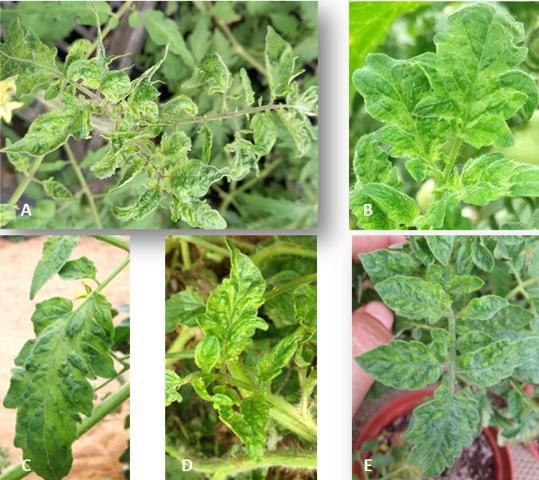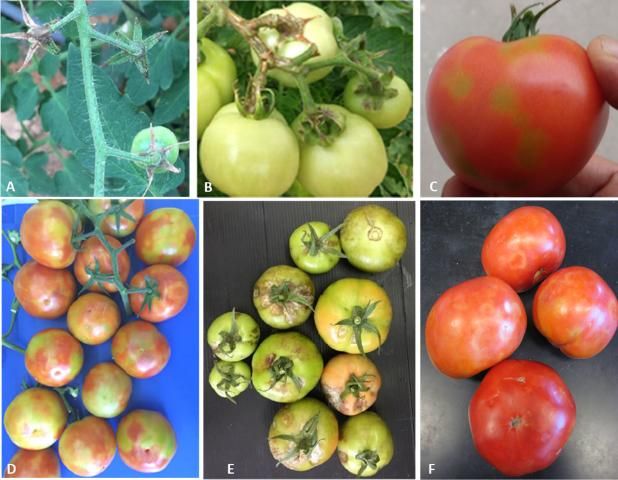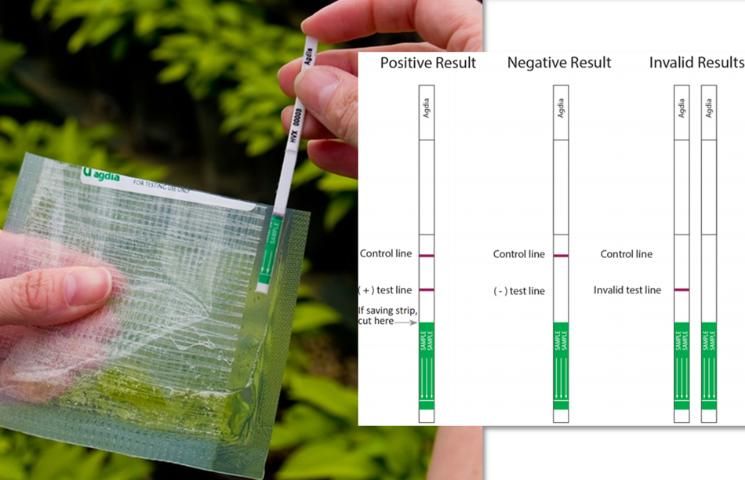Introduction
Tobamoviruses are mechanically-transmitted plant viruses that cause severe economic damage to vegetable and ornamental crops in Florida and worldwide. Tomato mosaic virus (ToMV) and tobacco mosaic virus (TMV) are the most commonly occurring tobamoviruses infecting tomato plants (Solanum lycopersicum) in Florida (Adams et al., 2009; Baker & Adkins, 2000). Tomato cultivars with resistance to these tobamoviruses are commercially available, and these were developed by introgression of resistance genes from wild plants into cultivated crops (Lanfermeijer et al., 2005).
Tomato cultivars harboring the Tm-22 resistance gene are resistant to ToMV, TMV, and other tobamoviruses (Hall, 1980; de Ronde et al., 2014). However, the Tm-22 resistance gene in tomato cultivars does not provide resistance against a recently described tobamovirus, tomato brown rugose fruit virus (ToBRFV), which was first detected in the Middle East (Salem et al., 2016; Luria et al., 2017). ToBRFV also infects pepper and eggplant (Luria et al., 2017; EPPO, 2019; Salem et al., 2020).
ToBRFV was initially detected in Jordan and Israel in 2014 and 2015, respectively, and is currently detected in tomato production areas worldwide. The emergence and spread of ToBRFV in tomato production areas, including California, Mexico, Jordan, Israel, Turkey, Italy, Germany, Greece and China has accelerated, representing a major economic concern (Cambrón-Crisantos et al., 2018; Fidan et al., 2019; Panno et al., 2019; Ling et al., 2019; Menzel et al., 2019; Yan et al., 2019; Beris et al., 2020).
No commercial tomato cultivars are known to be resistant to ToBRFV, even those previously resistant to other tobamoviruses. ToBRFV overcomes (breaks) the Tm-22 and all other resistance genes currently used to protect tomatoes against tobamoviruses. Although these genes are not routinely used in Florida field-grown tomato cultivars, it is presently unknown how ToBRFV may affect tomato production in Florida. Thus far, because of extensive crop handling and manipulations, ToBRFV has primarily been a threat to tomato production in protected cultures (greenhouses, screenhouses, and high tunnels), though outbreaks in open fields have been reported. In September 2019, ToBRFV was detected in fresh tomato fruits imported from Canada and Mexico for sale in Florida grocery stores (Dey et al., 2021). Since this first detection, ToBRFV has been found in tomato, pepper, and eggplant plants grown in non-commercial sites like community gardens in several locations in Florida. Furthermore, in more recent surveys conducted on grocery tomatoes in various grocery stores throughout Florida in 2020-2023, we continue to detect ToBRFV (and pepino mosaic virus in mixed infections) in tomatoes imported from other countries (Yilmaz and Batuman, 2023). Fortunately, we have not detected these viruses in field-grown tomatoes in Florida.
ToBRFV Characteristics
As a tobamovirus, ToBRFV shares several properties and disease symptoms with the more familiar members of this group that occur in Florida, including ToMV, TMV, and tomato mottle mosaic virus (ToMMV) (Li et al., 2013; Nagai et al., 2019; Webster et al., 2014).
Symptoms
It is impossible to identify a tobamovirus based on symptoms alone due to the similarity of symptoms induced by all tobamoviruses. In addition, symptoms vary depending on the virus's species and strain, the plant's growth stage when infected, and the tomato cultivar.
Generally, plants infected with a tobamovirus are stunted, and leaves show mosaic or mottling (green and yellow areas) and distortion (Figure 1A-E). In severe cases, leaf symptoms include elongation or ‘shoe-string’ like growth (Figure 1A). Maturing fruits show a range of symptoms, including no symptoms, some degree of deformation and chlorotic spots (i.e., uneven ripening or ‘marbling’), brown walls, and necrotic lesions (Figure 2).

Credit: Seminis(R); Fidan et al. (2019) and Luria et al. (2017)

Credit: A. Dombrovsky, O. Batuman, Fidan et al. (2019) and Luria et al. (2017)
How ToBRFV Is Different from Other Tobamoviruses
The main difference between ToBRFV and other tobamoviruses is that ToBRFV breaks the Tm-22 resistance gene and induces more severe fruit symptoms that, in some cases, include brown wrinkled (rugose) patches, especially when present in mixed infections with other tomato-infecting viruses (Figure 1E). Brown (necrotic) streaks may develop on stems, petioles and calices (Figure 2A and B). ToBRFV can be found in mixed infections with pepino mosaic virus (PepMV), a virus used for cross-protection in tomatoes produced in Canada and Europe. For instance, both viruses were identified in some of the Florida tomato fruits coming from Mexico and Canada.
Survival and Transmission
Tobamoviruses, including ToBRFV, are robust and can survive in plant debris for >10 years. Survival in soil and on contaminated objects or surfaces (benches, trellising ropes, plastic containers, and equipment) used in any production stage can range from months to years.
Tobamoviruses, including ToBRFV, are efficiently transmitted by contact, particularly in protected cultures where plants are frequently handled. Although most Florida field-tomato varieties are determinate and are tied several times throughout the season, they are not intensively handled (i.e., pruning and tying) by workers throughout the production cycle. There is no insect vector. However, bumble bees were shown to carry the virus in greenhouses (Levitzky et al. 2019). Thus, tobamoviruses may be less likely to spread extensively in open-field production systems. Tobamoviruses readily contaminate the seed coat and can be spread long distances with seeds, but the viruses are not believed to infect the embryo.
What to Do If You Think You Have ToBRFV in Your Field
Commercially available immunostrip (‘dipstick’) tests for ToBRFV, which cross-react with other tobamoviruses, including TMV, ToMV, and ToMMV, are available now. If you see tobamovirus-like symptoms in your tomato plants, use an immunostrip test for ToBRFV (Figure 3). If your tomato has virus-like symptoms and your test is positive by this assay, additional molecular tests (i.e., RT-PCR) are required for ToBRFV confirmation. If growers see unusual symptoms or suspect they may have a virus, they should immediately contact their local extension office for assistance or submit samples to their local UF-IFAS Plant Diagnostic Lab or FDACS-DPI (FDACS-DPI Helpline Number 352-395-4600).
The Florida Response
ToBRFV has rapidly spread globally in only a few years. It is highly virulent and is not controlled by currently available resistance genes. Although ToBRFV is not currently established in Florida, it was detected in imported tomato fruits sold in national chain grocery stores throughout Florida in 2019-2023 and a few community gardens in the fall of 2019. Therefore, we should take the following precautions to avoid the introduction of ToBRFV to tomato production fields:
- Seed companies, as a standard practice, currently test for the presence of tobamoviruses. Contact the seed company representatives you work with to ensure your seed is tested for tobamoviruses. Purchase only seeds certified to be ToBRFV-free.
- Inspect and discard tomato transplants with virus symptoms before planting in your field.
- Train your workers about ToBRFV (and potential occurrence in tomatoes sold in grocery stores) and implement sanitation measures such as washing hands and clothes before work, avoid bringing or touching tobacco and other potential host plant materials, and disinfect common tools, benches, and other equipment. Although undamaged fruit surfaces do not have viable virus particles, juice and other edible parts are highly infectious (Klap et al., 2020). Do NOT touch or bring tomato (or pepper) fruits from the outside into your production facilities.
- Monitor for virus symptoms to allow early detection if introduced into fields.

Credit: Agdia©
If you have additional questions or need assistance in testing, contact your local UF/IFAS Extension agent or Ozgur Batuman at UF/IFAS Southwest Florida Research and Education Center (email: obatuman@ufl.edu).
Summary
- ToBRFV is a recently described tobamovirus that impacts solanaceous crops such as tomatoes, peppers, and eggplants.
- ToBRFV is not currently established in Florida, but its continued presence in grocery stores, tomato fruits, and community gardens requires proactive preventative measures.
- What we know about this virus suggests that ToBRFV primarily threatens tomato production in protected cultures (greenhouses and screenhouses). However, a few outbreaks in Mexico and Israel have occurred in open fields.
- Genetic resistance is still being developed, but several seed companies may offer some cultivars with varying resistance (i.e., IR- or HR-resistant) to ToBRFV.
- ToBRFV is spread quickly and efficiently by contact with any infected plant material. Although it is not known to infect the seed (embryo), it can readily contaminate the seed coat (outside of seed) and can be spread long distance with the seed (and fruit).
- ToBRFV particles are robust and can survive for >10 years in soil, infected debris, or contaminated equipment and implements.
- Symptoms include mosaic and mottling on the leaves, irregular ripening and necrosis, and similar to other tobamoviruses.
- If ToBRFV is suspected, ToBRFV immunostrips can detect it, but confirmation will require further laboratory testing.
- Once the virus is introduced in an area, control measures are very limited and mainly rely on eliminating infected plants and following strict sanitation measures, such as regular hand washing of the workers, changing clothes, and cleaning boots before entering production areas.
Literature Cited
Adams MJ, Antoniw JF, Kreuze J. 2009. Virgaviridae: a new family of rod-shaped plant viruses. Arch Virol. 154(12):1967-72.
Baker C, Adkins S. 2000. Peppers, tomatoes and tobamoviruses (Plant Pathology Circular No. 400). Florida Department of Agriculture & Consumer Services, Division of Plant Industry, Gainesville, FL.
Beris D, Malandraki I, Kektsidou O, Theologidis I, Vassilakos N, Varveri C. First report of Tomato brown rugose fruit virus infecting tomato in Greece. Plant Disease. 2020 Mar 2(ja).
Cambrón-Crisantos JM, Rodríguez-Mendoza J, Valencia-Luna JB, Rangel SA, De Jesús García-Ávila C, López-Buenfil JA, 2018. First report of Tomato brown rugose fruit virus (ToBRFV) in Michoacan, Mexico. Mexican Journal of Phytopathology 37, 185-92.
de Ronde, D., Butterbach, P., and Kormelink, R. (2014). Dominant resistance against plant viruses. Frontiers in plant science, 5, 307.
Dey, K. K., Velez-Climent, M., Soria, P., Batuman, O., Mavrodieva, V., Wei, G., Zhou, J., Adkins, S., & McVay, J. 2021. First report of Tomato brown rugose fruit virus infecting tomato in Florida, USA. New Disease Reports, 44, e12028. https://doi.org/10.1002/ndr2.12028
EPPO Alert List – Tomato brown rugose fruit virus (Tobamovirus - ToBRFV).
Fidan H, Sarikaya P, Calis O, 2019. First report of Tomato brown rugose fruit virus on tomato in Turkey. New Disease Reports 39, 18.
Hall, T. J. (1980). Resistance at the Tm-2 locus in the tomato to tomato mosaic virus. Euphytica, 29(1), 189-197.
Klap C, Luria N, Smith E, Bakelman E, Belausov E, Laskar O, Lachman O, Gal-O, A, Dombrovsky A, 2020. The Potential Risk of Plant-Virus Disease Initiation by Infected Tomatoes. Plants 9, 623 https://doi.org/10.3390/plants9050623
Lanfermeijer FC, Warmink J, Hille J, 2005. The products of the broken Tm-2 and the durable Tm-22 resistance genes from tomato differ in four amino acids. Journal of experimental botany 56, 2925-33.
Levitzky N, Smith E, Lachman O, Luria N, Mizrahi Y, Bakelman H, et al. (2019) The bumblebee Bombus terrestris carries a primary inoculum of Tomato brown rugose fruit virus contributing to disease spread in tomatoes. PLoS ONE 14(1): e0210871. https://journals.plos.org/plosone/article?id=10.1371/journal.pone.0210871
Li R, Gao S, Fei Z, Ling K-S, 2013. Complete genome sequence of a new tobamovirus naturally infecting tomatoes in Mexico. Genome announcements 1, e00794-13.
Ling K-S, Tian T, Gurung S, Salati R, Gilliard A, 2019. First report of tomato brown rugose fruit virus infecting greenhouse tomato in the US. Plant Disease 103, 1439.
Luria N, Smith E, Reingold V, Bekelman I, Lapidot M, Levin I, Elad N, Tam Y, Sela N, Abu-Ras A, Ezra N and et al. 2017. A new Israeli Tobamovirus isolate infects tomato plants harboring Tm-22 resistance genes. PLOS ONE 12, e0170429.
Menzel W, Knierim D, Winter S, Hamacher J, Heupel M, 2019. First report of tomato brown rugose fruit virus infecting tomato in Germany. New Disease Reports 39, 2044.
Nagai A, Duarte LM, Chaves AL, Peres LE, Dos Santos DY, 2019. Tomato mottle mosaic virus in Brazil and its relationship with Tm-22 gene. European Journal of Plant Pathology, 1-7.
Panno S, Caruso A, Davino S, 2019. First Report of Tomato Brown Rugose Fruit Virus on Tomato Crops in Italy. Plant Disease 103, 1443.
Salem N, Mansour A, Ciuffo M, Falk B, Turina M, 2016. A new tobamovirus infecting tomato crops in Jordan. Archives of virology 161, 503-6.
Salem NM, Cao MJ, Odeh S, Turina M, Tahzima R. First Report of Tobacco Mild Green Mosaic Virus and Tomato Brown Rugose Fruit Virus Infecting Capsicum annuum in Jordan. Plant Disease. 2020 Feb 16;104(2):601.
Webster CG, Rosskopf EN, Lucas L, Mellinger HC, Adkins S. First report of tomato mottle mosaic virus infecting tomato in the United States. Plant health progress. 2014;15(4):151-2.
Yan ZY, Ma HY, Han SL, Geng C, Tian YP, Li XD. 2019. First report of tomato brown rugose fruit virus infecting tomato in China. Plant Disease. 103(11):2973.
Yilmaz, S. and Batuman, O. 2023. Co-Infection of Tomato Brown Rugose Fruit Virus and Pepino Mosaic Virus in Grocery Tomatoes in South Florida: Prevalence and Genomic Diversity. Viruses 2023, 15, 2305. https://doi.org/10.3390/v15122305